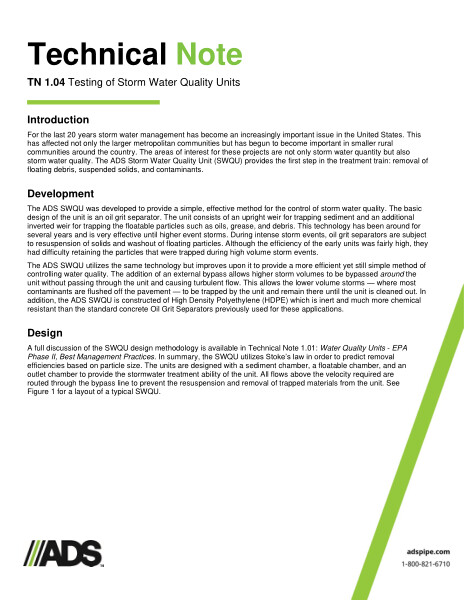TN 1.04 Testing of Storm Water Quality Units
Filename:
TN 1.04 Testing of Storm Water Quality Units.pdf

This document is the TN 1.04 Testing of Storm Water Quality Units. It describes the development, design and laboratory testing methods.
For the last 20 years storm water management has become an increasingly important issue in the United States. This has affected not only the larger metropolitan communities but has begun to become important in smaller rural communities around the country. The areas of interest for these projects are not only storm water quantity but also storm water quality. The ADS Storm Water Quality Unit (SWQU) provides the first step in the treatment train: removal of floating debris, suspended solids, and contaminants.
The ADS SWQU was developed to provide a simple, effective method for the control of storm water quality. The basic design of the unit is an oil grit separator. The unit consists of an upright weir for trapping sediment and an additional inverted weir for trapping the floatable particles such as oils, grease, and debris. This technology has been around for several years and is very effective until higher event storms. During intense storm events, oil grit separators are subject to resuspension of solids and washout of floating particles. Although the efficiency of the early units was fairly high, they had difficulty retaining the particles that were trapped during high volume storm events.
The ADS SWQU utilizes the same technology but improves upon it to provide a more efficient yet still simple method of controlling water quality. The addition of an external bypass allows higher storm volumes to be bypassed around the unit without passing through the unit and causing turbulent flow. This allows the lower volume storms — where most contaminants are flushed off of the pavement — to be trapped by the unit and remain there until the unit is cleaned out.
In addition, the ADS SWQU is constructed of High Density Polyethylene (HDPE) which is inert and much more chemical resistant than the standard concrete Oil Grit Separators previously used for these applications.
Laboratory testing and research for the ADS SWQU is summarized by testing protocol with supporting diagrams and value tables. Field testing and research is also discussed. Conclusions are based on the testing results.
